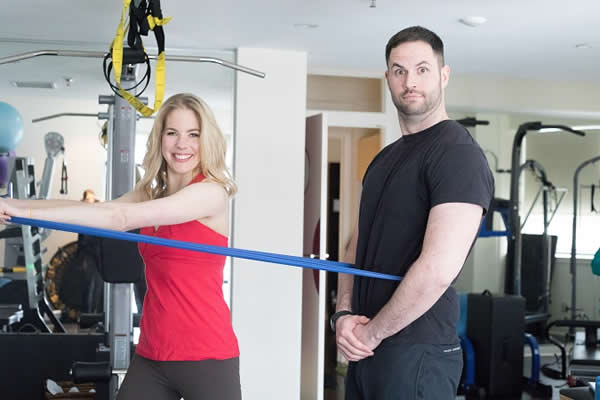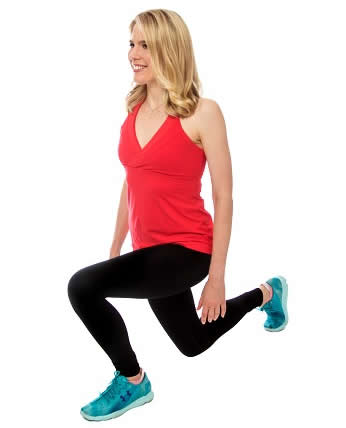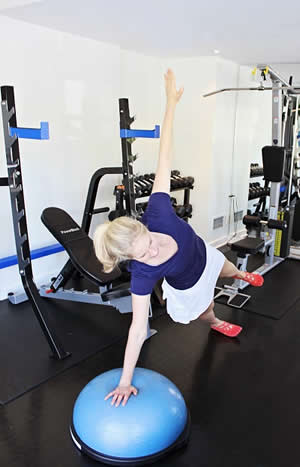Positive Health Online
Your Country

Train Your Brain: Exercise to Improve Neural Pathways and Memory and Decrease Mental Fog
by Kathleen Trotter(more info)
listed in exercise and fitness, originally published in issue 264 - August 2020
Exercise has neuroprotective qualities – it protects the brain. These neuroprotective qualities include increasing circulation to the brain; protecting skills such as memory, scheduling, planning, reasoning, and the ability to multitask; improving brain function and health; and facilitating adaptive possibilities such as neuroplasticity. Neuroplasticity is the ability of your brain to change and adapt – to reorganize itself, to create new neural pathways. Your brain creates new neural connections in response to stimuli. Stimuli can be anything from learning a new language, to sudokus to – you guessed it – exercise.
Exercise really is the Swiss Army knife of health – the miracle ‘pill’; not only does it positively impact mood, improve cardiovascular health, digestion, strength, functional mobility, and social connections, it also keeps the brain alive and adaptive.

Now, all exercise is neuroprotective, but various forms of exercise proportionally impact neuroprotective qualities to differing degrees. Broadly speaking, aerobic exercise is particularly useful in helping form new blood vessels and improving brain circulation. Strength, balance, and agility training – especially in relation to new motions – have a greater impact on neuroplasticity. This makes sense; neuroplasticity refers to the ability of the brain to “reorganize,” but the brain needs a reason to reorganize – a new stimulus, something to adapt to. So, when you first start running or swimming, the novelty will challenge your brain to create new pathways, but over time your brain will adapt to the activity’s repetitive requirements. Unless you are learning a new swimming stroke or adopting a new running gait, the need for the brain to adapt during repetitive cardiovascular activities is low.
Regular cardiovascular activity is key – it will keep your brain alive and bathed in oxygen – but walking alone is not enough. Two or three times a week you need to challenge your strength, balance, agility, and coordination. Your perfect exercise week should include cardio as well as movements that challenge your strength, balance, mobility, and coordination.
Aerobic Exercise: Improved Alertness and Overall Brain Health and Decreased Mental Fog
To improve your ability to focus, decrease the severity of mental fog, and foster general overall brain health, aim to do aerobic ‘cardio’ activities three to seven days a week. In this instance I am categorizing ‘cardio’ as repetitive cardiovascular activities such as cycling, walking, running, using the elliptical, etc. Basically, walk, bike, swim, or elliptical your way to improved blood circulation.
Exercise for Neural Plasticity
Think movements that challenge your strength, balance, coordination, and/or reactivity. The key is to work outside your comfort zone. Try things that make you feel like a newbie – a new sport, an iteration on an old exercise (instead of lunges, try clock taps or lunges), motions that challenge balance (lunges on a Bosu, or try closing your eyes at the bottom of a lunge).
Don’t be afraid to be bad at something. Doing something new – something your brain is not currently ‘wired for’ – is what sparks the need for a new neural pathway. Risk – within reason – looking goofy and feeling awkward. Sure, learning a new sport might feel embarrassing and standing on a balance board might feel unstable, but being new forces your body to learn.
Compare balance training and learning any new motion or sport to weight lifting: If you lift five pounds forever you will never get stronger. If you can already stand on one leg easily, that is your balance equivalent of lifting that five pounds. If you can already do a front crawl, that is your equivalent of lifting five pounds while swimming. A balance exercises you can already do are not balance exercises. A sporting technique you can already do will not push your brain to learn. To improve, you have to – within safe limits – work outside your comfort zone. Be safe, but challenge yourself. Think gradual progression.

Examples
- Move in multiple directions;
- Try clock taps: Stand on your left leg in the middle of an imaginary clock, right knee up. Engage your left bum muscle. A partner calls out a number. Tap your right foot to the corresponding number on the clock. If you don’t have a partner, just tap all the numbers on the clock; Or
- Clock lunges: Make clock taps a strength exercise by lunging toward (rather than taping) the number;
- Consider challenging your vision during exercise. Wear sunglasses, turn your head, or, when safe, close your eyes. Decreasing visual feedback will force your body to rely on other neural feedback;
- Consider using music;
- React to audio cues (for example, do squats while you listen for a beep, when you hear one you balance on one leg, etc.) or time motions to music (as with aerobics or dance);
- Incorporate higher-level problem-solving and, more important, verbal expression of problems;
- For example, use the clock lunge. Your partner calls out the number on the clock (let’s say 7 p.m.). You translate it into military time and say “nineteen hundred hours” while simultaneously lunging to the corresponding number on your imaginary clock;
- Or, incorporate a brain teaser. For example, count down (out loud) in sets of a prescribed number. For 13 burpees say the numbers backwards – in sets of seven – starting at 91. For 12 lunges say months backwards (December to January);
- Or, challenge your memory. For example, build a grocery list. Imagine your circuit is lunges, push-ups, and pull-ups. First, lunge and say apples. While doing push-ups say apples and grapes. When doing pull-ups say apples, grapes, chicken. During the second round of lunges say apples, gapes, chicken, and milk. And so on.

Add a Balance Element to any Exercise
Balance requires proprioception. Proprioception is the feedback loop between the body and brain; it’s the mind-body connection that allows your brain to know where you are in space and thus how your body should appropriately react. This proprioceptive neurological feedback loop is vital for everything from athletic maneuvers, to fall prevention, to improved posture, to injury prevention and foot strength. By challenging and training your balance, you also fine-tune your proprioception and require your brain to use its adaptive capabilities.
Incorporate unstable equipment, such as a Bosu, resistance ball, foam roller, or balance board into your main strength set.
- Instead of doing bench presses on a bench, do the exercise with your head and shoulders on a stability ball, your feet on the floor and your bum lifted in a bridge;
- Instead of doing push-ups on the floor, put your hands on either side of a Bosu, with the flat side up. Try to keep the Bosu stable as you do your push-ups;
- Instead of doing a crunch on the floor, lie lengthwise on a foam roller. Do a mini curl. As you curl, try to lift one leg off the floor without falling off of the roller;
- Use a Bosu to do step-ups, sideways step-ups, squats, and lunges.
Don’t have Equipment? No Problem
You can challenge your balance with only your own body. Stand on your left leg and lift your right leg off the ground. Hold for five seconds. Lower the foot but don’t touch down. Repeat three to 10 times. Then, without switching sides, hold your right leg up while rotating your head over and then away from the lifted knee. Repeat three times. Finally, lift the leg one last time and try to close your eyes. Then switch and repeat on the other leg.
Work on your Bio-Mechanics
Many of us perform movements with less-than-ideal loading patters. For example, have you been told to feel a squat in your bum, only to feel the work in your hip flexors? Hyper-facilitated hip flexors are a common compensation pattern in people who sit for long hours. Taking the time to learn how to recruit different, more ideal muscles, challenges the brain to create new neural pathways. I challenge you to research what muscles should be engaged in any exercise you perform regularly. If you discover that you exhibit faulty loading or recruitment patterns, work on fixing the pattern. For example, use tactile feedback by placing your hand on the muscle that should be working. As I tell my clients, “send your brain to the muscle you would like to turn on.”
Mix Up your Cardio
Two to three times a week add a multidirectional element to your cardio workouts. Many of us only do mindless forward-moving activities such as walking – an excellent activity, but your brain thrives on difference. Try dancing, doing a group exercise class that requires you to follow moves (e.g., Zumba or step), playing multi-directional sports (e.g., tennis), or incorporating sideways and backwards running into your workouts.
Two Final Thoughts
Don’t fall into the all-too-common limiting belief that workouts have to be long and onerous to be effective. You can challenge your balance by standing on one leg as you brush your teeth or standing on a balance cushion while you watch TV; mini bouts of cardiovascular activity are a great way to refocus and decrease mental fog throughout your work day. Schedule a short walk at lunch, pace as you take conference calls, and/or set an alarm to go off once an hour to remind you to move around for a few minutes. You will feel better, even if you just put on music and dance for 30 seconds. Even small breaks from sitting hunched in your chair will rejuvenate your mind and body!
Be patient – this is a process. Your kinesthetic/movement habits are like grooves in a record: the more frequently your past self-moved – or didn’t move – in a particular way, the deeper the groove will be. Be patient and, more important, be consistent. Regularly challenge your brain through exercise. The hour-long workout you do once a month is much less important than daily small bouts of activity. Make daily motion a non-negotiable – like brushing your teeth. It's a ‘when’ not an ‘if’. So, when are you going to move today?
Comments:
-
No Article Comments available